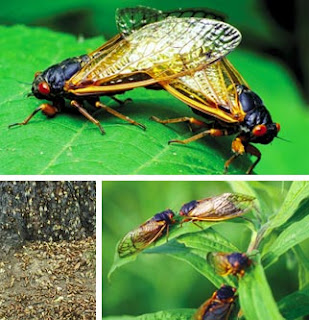The Insect with a Childhood of Seventeen Years
 The life cycle of most insects is relatively short, and many kinds pass from the egg to the adult stage within a few days or weeks. Others spend the winter months in the egg or other immature stage, and a few may require several years to become adults.
The life cycle of most insects is relatively short, and many kinds pass from the egg to the adult stage within a few days or weeks. Others spend the winter months in the egg or other immature stage, and a few may require several years to become adults.
The prize for the longest life cycle know in the insect world, however, must be awarded to the seventeen-year cicada. Cicadas are called locusts in some sections, but as we have seen, this name should be limited to certain members of the grasshopper clan. The rather common cicada which often gives a concert from tree during the day and early evening is familiar to many people. These insects are similar to the seventeen-year cicada, but their life cycle is completed in from two to five years.
The immature stages of cicadas are passed within the ground, where they burrow about and feed on the roots of various plants. Those of the seventeen-year species stay in the ground for seventeen years. So far as known, they do no serious damage to the plants on which they feed.
The rate of development of these numerous insects is about the same, and when they come from the ground they do so in tremendous numbers. At last the big moment arrives, and out from thr soil pop droves of the queerest insects you ever saw. Superficially they do not resemble adult cicadas to any extent. They are about an inch long, and they have large toothed from legs which cause them to resemble chubby crawfish. There is a pair of large eyesd on the head and small wing pads cab be seen on the back. These nymphs, as they are called, must now transform into adults. Each one grasps a rock or twig, or crawls up a tree trunk and catches the bark. The "skin" or outer shell then splits down the back. Gradually the adult insect works its way to the spot as a light brown shell.Seventeen-year cicadas emerge over a period of several days, and the adults may live for two or three weeks. Unlike the human species, only male cicadas can "sing", but while they are alive, a concentration of the insects is likely to make life miserable for people.
 Cicadas of one type or another occur in many parts of the world, but the seventeen-year species is confined to the eastern United States; a variety in the southeast requires only thirteen years to complete its life cycle. Most the the states east of the Mississippi River, and a few to the west, have one or more broods of these insects. There are many different broods, and each one emerges at a different time. Government and stage agencies have studied these various broods, and can predict the time when a particular group is to be expected.
Cicadas of one type or another occur in many parts of the world, but the seventeen-year species is confined to the eastern United States; a variety in the southeast requires only thirteen years to complete its life cycle. Most the the states east of the Mississippi River, and a few to the west, have one or more broods of these insects. There are many different broods, and each one emerges at a different time. Government and stage agencies have studied these various broods, and can predict the time when a particular group is to be expected.The cicadas sometimes cause damage to trees, but the destruction is not as much as one might expect from such tremendous numbers. Essentially all harm is done by the egg-laying females. The cicada pushes the ovipositor or egg-laying tube into the bark of small twigs and limbs, and the eggs are deposited in the tissues of the plant. The twigs are punctured and splintered during the process, and valuable fruit trees may be heavily damaged or even killed if enough cicadas are present. When the eggs hatch, the nymphs drop to the ground, burrow into the soil, and remain there for their destined thirteen or seventeen years.









0 comments:
Post a Comment